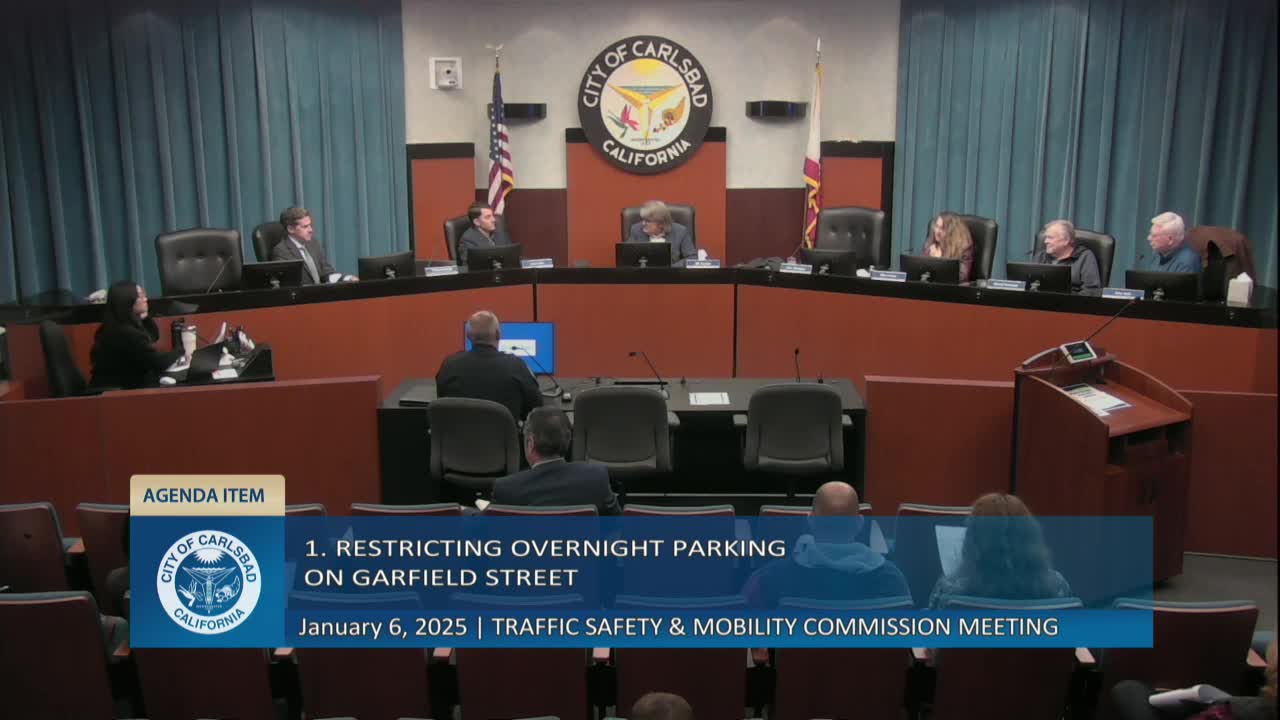Commission reviews draft 2025 revisions to Carlsbad residential traffic management program; staff proposes removing stop-signs from toolbox
January 06, 2025 | Carlsbad, San Diego County, California
This article was created by AI summarizing key points discussed. AI makes mistakes, so for full details and context, please refer to the video of the full meeting. Please report any errors so we can fix them. Report an error »

City traffic staff presented proposed revisions to the Carlsbad Residential Traffic Management Program (CRTMP) Jan. 6, asking the Traffic Safety and Mobility Commission for feedback before the draft goes to City Council.
John Kim, city traffic engineer, and Miriam James, senior engineer, explained the proposed changes to the program used to evaluate and implement traffic calming on residential streets. Key revisions: remove stop signs from the program toolbox (staff cited the California Manual on Uniform Traffic Control Devices guidance that stop signs should not be used for speed control), remove high-visibility crosswalk markings as a standalone toolbox measure, limit deployment of temporary speed-feedback signs on the same street to once every two years, change the program structure from three phases to two phases (education/enforcement and physical traffic-calming measures), and require non-rounded mail-survey support of at least 67% and a 50% return rate before implementation.
Staff said Phase 3 measures have not been used since the program’s 2001 adoption and that Phase 2 measures such as speed cushions, traffic circles and curb extensions generally address reported issues. The draft also adds an option for resident-led petitions to request exceptions for streets that do not meet the 32 mph “critical speed” threshold ordinarily needed to advance to Phase 2, and it clarifies that traffic calming on non-residential streets will follow the Mobility Element of the General Plan.
Kim and James provided a 2024 update: staff advanced Phase 2 on 11 residential streets, eight of which won neighborhood support and City Council approval; construction has been completed on four streets and is underway on four more.
Commissioners and members of the public asked technical and policy questions. A commissioner suggested updating older speed-cushion pavement markings and ensuring cushion edge slopes reduce the risk to bicyclists; staff confirmed standards exist and said older installations would be updated. Another asked about the rationale for the 50% mail-survey return and 67% support thresholds; staff said the percentages were drawn from practices reviewed during past program development and that a recent project clarified the need to remove rounding in the standard.
Next steps: staff will finalize the draft, return with the document for additional commission review and then present the revisions to City Council for adoption.
John Kim, city traffic engineer, and Miriam James, senior engineer, explained the proposed changes to the program used to evaluate and implement traffic calming on residential streets. Key revisions: remove stop signs from the program toolbox (staff cited the California Manual on Uniform Traffic Control Devices guidance that stop signs should not be used for speed control), remove high-visibility crosswalk markings as a standalone toolbox measure, limit deployment of temporary speed-feedback signs on the same street to once every two years, change the program structure from three phases to two phases (education/enforcement and physical traffic-calming measures), and require non-rounded mail-survey support of at least 67% and a 50% return rate before implementation.
Staff said Phase 3 measures have not been used since the program’s 2001 adoption and that Phase 2 measures such as speed cushions, traffic circles and curb extensions generally address reported issues. The draft also adds an option for resident-led petitions to request exceptions for streets that do not meet the 32 mph “critical speed” threshold ordinarily needed to advance to Phase 2, and it clarifies that traffic calming on non-residential streets will follow the Mobility Element of the General Plan.
Kim and James provided a 2024 update: staff advanced Phase 2 on 11 residential streets, eight of which won neighborhood support and City Council approval; construction has been completed on four streets and is underway on four more.
Commissioners and members of the public asked technical and policy questions. A commissioner suggested updating older speed-cushion pavement markings and ensuring cushion edge slopes reduce the risk to bicyclists; staff confirmed standards exist and said older installations would be updated. Another asked about the rationale for the 50% mail-survey return and 67% support thresholds; staff said the percentages were drawn from practices reviewed during past program development and that a recent project clarified the need to remove rounding in the standard.
Next steps: staff will finalize the draft, return with the document for additional commission review and then present the revisions to City Council for adoption.
View full meeting
This article is based on a recent meeting—watch the full video and explore the complete transcript for deeper insights into the discussion.
View full meeting
